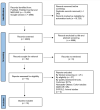Statins' Effect on Cognitive Outcome After Traumatic Brain Injury: A Systematic Review
- PMID: 34405076
- PMCID: PMC8352842
- DOI: 10.7759/cureus.16953
Statins' Effect on Cognitive Outcome After Traumatic Brain Injury: A Systematic Review
Abstract
Traumatic brain injury (TBI), also known as the "Silent Epidemic," is a growing devastating global health problem estimated to affect millions of individuals yearly worldwide with little public recognition, leading to many individuals living with a TBI-related disability. TBI has been associated with up to five times increase in the risk of dementia among multiple neurologic complications compared with the general population. Several therapies, including statins, have been tried and showed promising benefits for TBI patients. In this systematic review, we evaluated the recent literature that tested the role of statins on neurological and cognitive outcomes such as Alzheimer's Disease and non-Alzheimer's dementia in survivors of TBI with various severities. We conducted a systematic search on PubMed, PubMed Central, MEDLINE, and Google Scholar. MeSH terms and keywords were used to search for full-text randomized clinical trials (RCTs), cross-sectional, case-control, cohort studies, systematic reviews, and animal studies published in English. Inclusion and exclusion criteria were applied, and the articles were subjected to quality appraisal by two reviewers. Our data search retrieved 4948 nonduplicate records. A total of 18 studies were included - nine human studies, and nine animal laboratory trials - after meeting inclusion, eligibility, and quality assessment criteria. Simvastatin was the most tested statin, and the oral route of administration was the most used. Eight human studies showed a significant neuroprotective effect and improvement in the cognitive outcomes, including dementia. Four randomized clinical trials with 296 patients showed that statins play a neuroprotective role and improve cognitive outcomes through different mechanisms, especially their anti-inflammatory effect; they were shown to lower tumor necrosis factor (TNF)-α and C-reactive protein (CRP) levels. Also, they decreased axonal injury and cortical thickness changes. In addition, four cohort studies compared a total of 867.953 patients. One study showed a decrease in mortality in statin-treated patients (p=0.05). Another study showed a reduction in the incidence of Alzheimer's disease and related dementias (RR, 0.77; 95% CI, 0.73-0.81), while one study showed a decreased risk of dementia after concussions by 6.13% (p=0.001). On the other hand, one cohort study showed no significant difference with the use of statins. In eight animal trials, statins showed a significant neuroprotective effect, improved cognitive outcomes, and neurological functions. Different molecular and cellular mechanisms were suggested, including anti-inflammatory effects, promoting angiogenesis, neurogenesis, increasing cerebral blood flow, neurite outgrowth, promoting the proliferation and differentiation of neural stem cells, and reducing axonal injury. On the contrary, one study showed no benefit and actual adverse effect on the cognitive outcome. Most of the studies showed promising neuroprotective effects of statins in TBI patients. Cognitive outcomes, especially dementia, were improved. However, the optimal therapeutic protocol is still unknown. Thus, statins are candidates for more advanced studies to test their efficacy in preventing cognitive decline in patients with TBI.
Keywords: alzheimer's disease; cognitive decline; concussion; dementia; statins; traumatic brain injury.
Copyright © 2021, Sultan et al.
Conflict of interest statement
The authors have declared that no competing interests exist.
Figures




References
-
- Traumatic brain injury: giving voice to a silent epidemic. Rusnak M. Nat Rev Neurol. 2013;9:186–187. - PubMed
-
- Traumatic brain injury. Heegaard W, Biros M. Emerg Med Clin North Am. 2007;25:655–678. - PubMed
-
- Traumatic brain injuries evaluated in U.S. emergency departments, 1992-1994. Jager TE, Weiss HB, Coben JH, Pepe PE. Acad Emerg Med. 2000;7:134–140. - PubMed
-
- Estimating the global incidence of traumatic brain injury. Dewan MC, Rattani A, Gupta S, et al. J Neurosurg. 2018;130:1080–1097. - PubMed
Publication types
LinkOut - more resources
Full Text Sources
Research Materials
Miscellaneous
